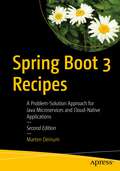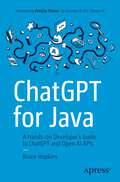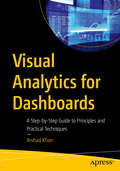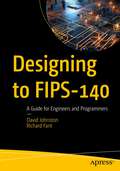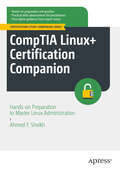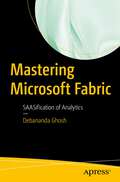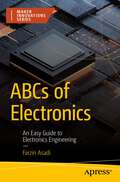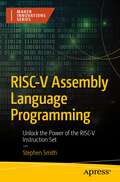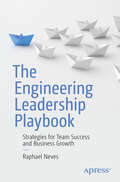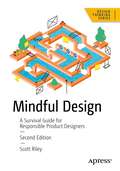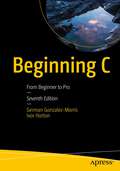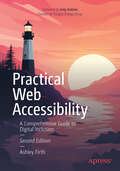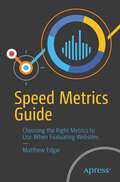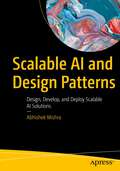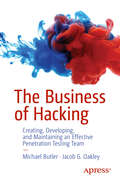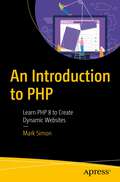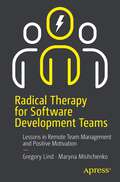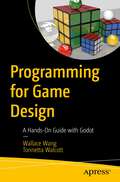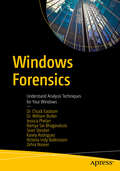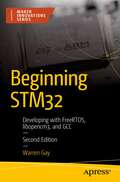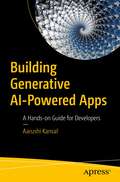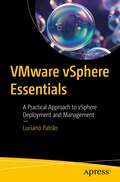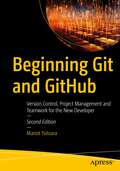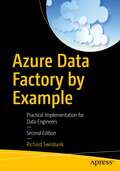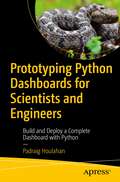- Table View
- List View
Spring Boot 3 Recipes: A Problem-Solution Approach for Java Microservices and Cloud-Native Applications
by Marten DeinumSolve all your Spring Boot 3 micro-framework problems using complete, real-world Java-based code snippets and examples inspired by various problems and corresponding solutions to those problems . When you start a new project, you’ll be able to copy the code and configuration files from this book, and then modify them for your own specific software programming needs. This can save you a great deal of work over creating a project from scratch.Spring Boot 3 Recipes has been revised to include new features like the new Spring Native, newly repackaged Spring Data, Spring Kafka for messaging and more on Kubernetes/deployment than in the previous edition. It includes Java 17 long term support code and Jakarta EE 9+ code as a base for Spring Boot 3. This handy code reference takes advantage of these things as it introduces you to VMWare's Spring Boot 3 and Spring Native. Quickly, it dives into code snippets on how to apply and integrate SpringBoot 3 with the Spring MVC web framework, web sockets and WebFlux for the rapid development of web applications, web services, microservices and more. You'll also get solutions to common problems with data persistence, integrating Spring Boot with batch processing, algorithmic programming via Spring Batch, and much more. These enable you to enhance or round out your web applications or microservices with a data and/or transaction-tier to boot. Other recipes cover topics such as using and integrating Boot with Spring's enterprise services, Spring Integration, testing, monitoring and more.At the end of the book, you'll have the code snippets and packages to deploy your Spring Boot-created microservices or applications on a cloud platform like Amazon using the popular Kubernetes container. Finally, this code reference is a must have for your Spring library. What You'll LearnGet reusable code recipes and snippets for the Spring Boot 3 micro-framework Discover how Spring Boot 3 integrates with other Spring APIs, tools, and frameworksAccess Spring MVC, web sockets and WebFlux for easier web developmentWork with microservices for web services development and integration with your Spring Boot applicationsAdd persistence and a data tier seamlessly to make your Spring Boot web application do moreIntegrate enterprise services via Spring Integration and Jakarta EE to create a more complex Java application using Spring BootWho This Book Is ForThis book is for experienced Java and Spring software programmers, developers.
ChatGPT for Java: A Hands-on Developer's Guide to ChatGPT and Open AI APIs
by Bruce HopkinsEmbrace the future of software development! ChatGPT for Java is the perfect starting point for Java developers to learn how to build intelligent applications using ChatGPT and Open AI APIs.This book takes you from the ground up to demonstrate how to use ChatGPT programmatically. You will learn the basics of ChatGPT and OpenAI APIs, including how to authenticate, send prompts, generate responses, test in the Playground, and handle errors. Each chapter includes practical exercises which demonstrate different API functionalities and bring your concepts to life. You will learn how to AI-enable your own applications using models such as GPT-4, GPT-3.5, Whisper, DALL-E, and many more. As a result, developers will understand that generative AI tools will not replace software development jobs! Instead, you will leverage ChatGPT as your Java AI-pair programmer to increase speed and productivity. You will also learn how ChatGPT can provide powerful Natural Language Processing (NLP) capabilities to your Java apps in order to understand various formats of unstructured text. Step-by-step, you will apply the concepts covered to create your own intelligent chatbots that can automatically process messages from either Slack on Discord. With this book, Java developers will be empowered to take their applications to new heights by leveraging the power of AI as this exciting field continues to evolve and transform.What You Will LearnAuthenticate with the ChatGPT and OpenAI APIs and learn how to engineer and send promptsTest your prompts in the ChatGPT PlaygroundHow to use multiple artificial intelligence models Harness the power the temperature, top_p, and other parameters that can ONLY be accessed by developers to create more unique and engaging responses from ChatGPTCreate intelligent bots for Slack or Discord serversIncorporate context into prompts for betterresponses and apply advanced features of the APIs.Explore future directions for ChatGPT and OpenAI Who This Book Is ForBeginning and intermediate Java developers who have a basic understanding of Java programming concepts and are interested in learning how to add intelligence to their applications by using ChatGPT programmatically. No prior experience with ChatGPT or OpenAI APIs is required.
Visual Analytics for Dashboards: A Step-by-Step Guide to Principles and Practical Techniques
by Arshad KhanThis book covers the key principles, best practices, and practical techniques for designing and implementing visually compelling dashboards. It explores the various stages of the dashboard development process, from understanding user needs and defining goals, to selecting appropriate visual encodings, designing effective layouts, and employing interactive elements. It also addresses the critical aspect of data storytelling, examining how narratives and context can be woven into dashboards to deliver impactful insights and engage audiences. Visual Analytics for Dashboards is designed to cater to a wide range of readers, from beginners looking to grasp the fundamentals of visual analytics, to seasoned professionals seeking to enhance their dashboard design skills. For different types of readers, such as a data analyst, BI professional, data scientist, or simply someone interested in data visualization, this book aims to equip them with the knowledge and tools necessary to create impactful dashboards. What you’ll learn The principles of data visualization How to create effective dashboards Meet all the requirements for visual analytics/data visualization/dashboard courses Deepen understanding of data presentation and analysis How to use different kinds of tools for data analysis, such as scorecards and key performance indicators Who This Book Is For Business analysts, data analysts, BI professionals, end-users, executives, developers, as well as students in dashboards, data visualizations, and visual analytics courses.
Designing to FIPS-140: A Guide for Engineers and Programmers
by David Johnston Richard FantThis book provides detailed and practical information for practitioners to understand why they should choose certification. It covers the pros and cons, and shows how to design to comply with the specifications (FIPS-140, SP800 documents, and related international specs such as AIS31, GM/T-0005-2021, etc.). It also covers how to perform compliance testing. By the end of the book, you will know how to interact with accredited certification labs and with related industry forums (CMUF, ICMC). In short, the book covers everything you need to know to make sound designs.There is a process for FIPS-140 (Federal Information Processing Standard) certification for cryptographic products sold to the US government. And there are parallel certifications in other countries, resulting in a non-trivial and complex process. A large market of companies has grown to help companies navigate the FIPS-140 certification process. And there are accredited certification labs you must contract toget the certification.Although this was once a fairly niche topic, it is no longer so. Other industries—banking, military, healthcare, air travel, and more—have adopted FIPS certification for cryptographic products. The demand for these services has grown exponentially. Still, the available skills pool has not grown. Many people are working on products with zero usable information on what to do to meet these standards and achieve certification or even understand if such certification applies to their products. What You Will Learn What is FIPS-140? What is the SP800 standard?What is certification? What does it look like? What is it suitable for?What is NIST? What does it do?What do accredited certification labs do?What do certification consultants do?Where and when is certification required?What do FIPS-140 modules look like?What are the sub-components of FIPS-140 modules (RNGs, PUFs, crypto functions)? How does certification work for them?What are the physical primitives (RNGs, PUFs, key stores) and how do you handle the additional complexity of certifying them under FIPS?What are the compliance algorithms (AES, SP800-90 algos, SHA, ECDSA, key agreement, etc.)?How do you design for certification (BIST, startup tests, secure boundaries, test access, zeroization, etc.)?How do you get CAVP certificates (cert houses, ACVTs)?How do you get CMVP certifications (cert houses, required documents, design information, security policy, etc.)? Who This Book Is For Hardware and software engineers or managers of engineering programs that include any form of cryptographic functionality, including silicon vendors, library vendors, OS vendors, and system integrators
CompTIA Linux+ Certification Companion: Hands-on Preparation to Master Linux Administration (Certification Study Companion Series)
by Ahmed F. SheikhThe CompTIA Linux+ Certification" book – the ultimate guide to mastering Linux system administration in preparation for the CompTIA Linux+ Certification. Whether you're a beginner or an experienced professional, this comprehensive resource is designed to equip you with the knowledge and skills needed to excel in the world of Linux.With its comprehensive coverage, this book delves into essential Linux concepts, commands, and techniques, providing you with a complete reference guide. You'll review how to customize and navigate the shell environment, write powerful scripts, configure user interfaces, perform administrative tasks, configure system services, establish network connections, and secure your system. No stone is left unturned in this in-depth exploration of Linux administration.What sets this book apart is its practical approach. Real-world scenarios and practical applications take center stage, ensuring that you not only understand the theory but also know how to apply it effectively.Troubleshooting common issues becomes second nature as you gain the skills to diagnose and resolve system problems with ease. You'll discover industry best practices and standards, enabling you to optimize systems, implement robust security measures, and adhere to compliance regulations.What You Will Learn:Linux operating systems, including installation, configuration, and management of Linux-based servers and systems. Essential administrative tasks, such as user and group management, file system administration, network configuration, and security implementation.Insights into troubleshooting common Linux issues, enabling readers to diagnose and resolve system problems effectively. Practical techniques for identifying and addressing system errors, performance bottlenecks, network connectivity issues, and other challenges that may arise in a Linux environment.Industry best practices and standards in Linux administration. System optimization, backup and recovery strategies, security practices, and adherence to compliance regulations.Who This Book is for:Administrators: This book serves as an excellent resource for individuals who are new to Linux administration and wish to develop a strong foundation in this field. They may have basic knowledge of Linux concepts or come from related IT roles and seek to expand their skills to include Linux system management.IT Professionals Transitioning to Linux: Professionals already working in the IT industry, such as system administrators or network engineers, who want to enhance their skill set and broaden their knowledge by incorporating Linux administration into their repertoire. They may have experience with other operating systems and are seeking to acquire Linux-specific skills.Experienced Linux Administrators: Seasoned Linux administrators can benefit from this book as well. It serves as a comprehensive reference guide, offering advanced topics, best practices, and insights into the latest trends and developments in the Linux ecosystem. It can be a valuable resource for expanding their expertise and staying up-to-date with industry standards.Secondary or tertiary audiences may include IT managers, system architects, or developers who work closely with Linux systems and wish to gain a deeper understanding of Linux administration. Additionally, students pursuing computer science or IT-related degrees may find the book beneficial for their coursework and career advancement.
Mastering Microsoft Fabric: SAASification of Analytics
by Debananda GhoshLearn and explore the capabilities of Microsoft Fabric, the latest evolution in cloud analytics suites. This book will help you understand how users can leverage Microsoft Office equivalent experience for performing data management and advanced analytics activity. The book starts with an overview of the analytics evolution from on premises to cloud infrastructure as a service (IaaS), platform as a service (PaaS), and now software as a service (SaaS version) and provides an introduction to Microsoft Fabric. You will learn how to provision Microsoft Fabric in your tenant along with the key capabilities of SaaS analytics products and the advantage of using Fabric in the enterprise analytics platform. OneLake and Lakehouse for data engineering is discussed as well as OneLake for data science. Author Ghosh teaches you about data warehouse offerings inside Microsoft Fabric and the new data integration experience which brings Azure Data Factory and Power Query Editor of Power BI together in a single platform. Also demonstrated is Real-Time Analytics in Fabric, including capabilities such as Kusto query and database. You will understand how the new event stream feature integrates with OneLake and other computations. You also will know how to configure the real-time alert capability in a zero code manner and go through the Power BI experience in the Fabric workspace. Fabric pricing and its licensing is also covered.After reading this book, you will understand the capabilities of Microsoft Fabric and its Integration with current and upcoming Azure OpenAI capabilities.What You Will LearnBuild OneLake for all data like OneDrive for Microsoft OfficeLeverage shortcuts for cross-cloud data virtualization in Azure and AWSUnderstand upcoming OpenAI integrationDiscover new event streaming and Kusto query inside Fabric real-time analyticsUtilize seamless tooling for machine learning and data scienceWho This Book Is ForCitizen users and experts in the data engineering and data science fields, along with chief AI officers
ABCs of Electronics: An Easy Guide to Electronics Engineering (Maker Innovations Series)
by Farzin AsadiLearn the fundamental principles of electronic components in a simple, easy-to-follow text. This book is a must-have for anyone seeking to master the basics of electronic engineering.Completely avoiding unnecessary complex technical concepts and highly mathematical terms, chapters are presented in simple language, using analogies that are familiar to everyone. From deciphering schematics to practical implementation, the knowledge imparted in these pages opens doors to exciting possibilities. You'll gain a solid understanding of crucial components like diodes, transistors, relays, ICs, DC motors, and more.Whether you're a student looking to grasp the fundamentals or a maker eager to bring your projects to life, ABCs of Electronics is your essential companion. What You'll LearnGain the skills to read and implement electronic schematicsDevelop a practical understanding of digital electronics, logic gates, and prototyping platforms.Discover how to work with DC motors and relays for various electronic applications.Acquire essential electronics knowledge Simplify the complexities of electronics and offer practical, hands-on guidance.Who This Book Is ForMakers, high school and college students pursuing electronic engineering, individuals with a general interest in electronics, and anyone seeking a practical and simplified approach to learning the fundamentals of electronics.
RISC-V Assembly Language Programming: Unlock the Power of the RISC-V Instruction Set (Maker Innovations Series)
by Stephen SmithGain the skills required to dive into the fundamentals of the RISC-V instruction set architecture. This book explains the basics of code optimization, as well as how to interoperate with C and Python code, thus providing the starting points for your own projects as you develop a working knowledge of assembly language for various RISC-V processors.The RISC-V processor is the new open-source CPU that is quickly gaining popularity and this book serves as an introduction to assembly language programming for the processor in either 32- or 64-bit mode. You’ll see how to write assembly language programs for several single board computers, including the Starfive Visionfive 2 and the Espressif ESP32-C3 32-bit RISC-V microcontroller. The book also covers running RISC-V Linux with the QEMU emulator on and Intel/AMD based PC or laptop and all the tools required to do so.Moving on, you’ll examine the basics of the RISC-V hardware architecture, all the groups of RISC-V assembly language instructions and understand how data is stored in the computer’s memory. In addition, you’ll learn how to interface to hardware such as GPIO ports. With RISC-V Assembly Language Programming you’ll develop enough background to use the official RISC-V reference documentation for your own projects.What You'll LearnProgram basic RISC-V Assembly LanguageSee how data is represented and stored in a RISC-V based computerMake operating system calls from Assembly Language and include other software libraries in projectsInterface to various hardware devicesComprehend code containing Assembly LanguageReverse engineer and hack codeUse the official RISC-V reference documentationWho This Book Is ForThose who have already learned to program in a higher-level language like Python, Java, C# or even C and now wish to learn Assembly Language programming.
The Engineering Leadership Playbook: Strategies for Team Success and Business Growth
by Raphael NevesIn today's business landscape, software engineering teams must deliver innovation faster than ever. However, outdated management approaches centered on tools and metrics rather than people strangle velocity and creativity. Legacy leaders cling to rigid structures mismatched with market dynamics, draining effort and morale from burnt-out teams. The Engineering Leadership Playbook provides a modern framework to unlock your team's potential through empathy, clarity, and empowerment. Unlike traditional leadership books fixated on delivery metrics, Raphael Neves offers a refreshing people-oriented leadership model tailored to nuances of engineering culture. With 15+ years leading high-growth tech teams, Raphael demystifies how to balance autonomy with alignment, reconstruct feedback models on psychological safety, and sustain excellence amidst uncertainty. You'll learn his proven conflict resolution blueprint for defusing clashes through mutual understanding while tangibly tracking progress. Additionally, his continuous feedback system grounded in evidence spotlights gaps early while accelerating strengths. This playbook moves systematically from foundational concepts like emotional intelligence and leading by example into team development frameworks around high-impact coaching, mentorship, and performance reviews. The method is brought full circle through innovation catalysts that maintain creative momentum at scale. Step-by-step, Raphael unpacks human-centered leadership aligned with accelerating market realities. Apply his engineering management playbook, and your teams will thrive fueled by vision, trust, and care. What You'll Learn Study different leadership styles and how to switch their approaches depending on circumstances Review critical communication skills, especially in technical fields Create IDPs for team members, especially senior engineers and leaders Who This Book Is For Current engineering leaders, aspiring engineering leaders, senior engineers, HR professionals and recruiters, and professionals in related fields
Mindful Design: A Survival Guide for Responsible Product Designers (Design Thinking)
by Scott RileyLearn to create seamless designs backed by a responsible understanding of the human mind. This new edition is fully updated and reworked to employ a realistic, challenging, and practical approach to interface design, presenting state of the art scientific studies in behavioral sciences, interface design and the psychology of design. All with modern, up-to-date examples and screenshots. The practical portion of this edition has been completely reworked, giving you the chance to follow along with a real, proven design process that has produced several successful products imbued with the principles of mindful, responsible design.You'll examine how human behavior can be used to integrate your product design into lifestyle, rather than interrupt it, and make decisions for the good of those that are using your product. You will also learn about the neurological aspects and limitations of human vision and perception; about our attachment to harmony and dissonance; and about our brain’s propensity towards pattern recognition and how we perceive the world around us. In the second half of the book, you’ll follow along with the key phases of a design project, implementing what you have learned in an end-to-end, practical setting. Design is a responsibility, but not enough designers understand the human mind or the process of thought. Mindful Design, Second Edition introduces the areas of brain science that matter to designers, and passionately explains how those areas affect each human’s day-to-day experiences with products and interfaces, providing a battle-tested toolkit to help you make responsible design decisions. What You'll Learn Review how attention and distraction work and the cost of attentional switchingUse Gestalt principles to communicate visual groupingEnsure your underlying models make sense to your audienceUse time, progression, and transition to create a compositionCarefully examine controlling behavior through reductionist and behaviorist motivation concepts Apply the theoretical knowledge to practical, mindful interface design Who This Book Is For The primary audience for this book is professional designers who wish to learn more about the human mind and how to apply that to their work. The book is also useful for design-focused product owners and startup founders who wish to apply ethical thinking to a team, or when bootstrapping their products. The secondary audience is design students who are either studying a ‘traditional’ visual design course, or a UX/interaction design course who have a desire to learn how they might be able to apply mindful design to their early careers. Finally, a tertiary audience for this book would be tutors involved in teaching design, or peripheral, courses who may wish to incorporate its teachings into their lectures, workshops or seminars.
Beginning C: From Beginner to Pro
by German Gonzalez-Morris Ivor HortonLearn how to program using C, beginning from first principles and progressing through step-by-step examples. This seventh edition is fully updated to reflect new features of C23, and addresses deprecated functions and features that are no longer supported.You’ll discover that C is a foundation language that every programmer ought to know. Beginning C is written by renowned author Ivor Horton and expert programmer German Gonzalez-Morris. This book increases your programming expertise by guiding you through the development of fully working C applications that use what you've learned in a practical context. Examples of how to use deprecated functions are also provided, along with new examples for replacing them when a simple solution is possible.By the end of the book you'll be confident in your skills with all facets of the widely-used and powerful C language and be able to strike out on your own by trying the exercises included at the end of each chapter. All you need are this book and any of the widely available C compilers, and you'll soon be writing real C programs. What You Will Learn Discover the C programming languageProgram using C starting with first steps, then making decisionsUse loops, arrays, strings, text, pointers, functions, I/O, and moreCode applications with strings and textStructure your programs efficientlyWork with data, files, facilities, and more Who This Book Is For Those new to C programming who may or may not have some prior programming experience.
Practical Web Accessibility: A Comprehensive Guide to Digital Inclusion
by Ashley FirthEveryone deserves to use the Internet. An estimated 1.3 billion people experience significant disability. That’s 16percent of the world’s population, or one in six of us. At the same time, over 96 percent of the one million most popular websites have an accessibility issue. Add to this the massive rise in legal cases around sites not being accessible, including Beyoncé, Disney, and Netflix, and you have an important topic that more and more people are starting to engage with.In this updated and revamped second edition of the Amazon technology chart-topping Practical Web Accessibility, you’ll be guided through a broad range of disabilities and access needs. You’ll understand the ways these users typically engage with the web, the barriers they often face, and practical advice on how your websites and content can be compliant, but more than that, inclusive and enjoyable to use. There’s also a new chapter on “Outsourcing Accessibility,” exploring third party “bolt-on” tools, “build your own website” platforms like Wix, and popular design systems. You‘ll explore whether they’re helpful or detrimental in the fight to make the web more accessible.Throughout this book you’ll learn to test for, spot, and fix web accessibility issues for a wide range of physical and mental impairments. Featuring content from the latest compliance frameworks, including the newly released WCAG 2.2 and exploratory concepts in WCAG 3, you’ll see how to go beyond the basic requirements in order to help your users. You’ll also learn that an accessible approach won’t just help people with disabilities, it will improve your website for everyone.This book comes complete with practical examples you can use in your own sites, along with a brand-new approach to auditing and improving a website’s accessibility, and a team’s approach to it, based on tools created by the author and refined over years as a consultant — The FAIR framework and ACCESS checklist. With these tools, you can set up processes for yourself and your team that will drastically improve the accessibility of your sites and, importantly, keep them that way in the future. Suitable for those of any profession or experience level, Practical Web Accessibility gives you all the information you need to ensure that your sites are truly accessible for the modern, inclusive web. If you would like to learn about web accessibility in a clear and actionable way, this book is for you.What You Will LearnA greater understanding of a vast range of disabilities that have online access needs, and the issues they typically face accessing content online.Ways to apply the practical steps required to cater for those needs.How to take your sites, and colleagues, on a journey from being inaccessible to accessible.The importance of accessibility in your designs, code, content, and more.The best ways to test andimprove your sites, so you can be compliant, and truly accessible. Who This Book Is For Anyone, regardless of what they do, who wants to learn how to make websites and their content more accessible for those with disabilities. In the world of web, the book has been used by front and backend developers, designers, product and project managers, team and business leaders.
Speed Metrics Guide: Choosing the Right Metrics to Use When Evaluating Websites
by Matthew EdgarFaster websites offer a better user experience and typically have higher conversion rates. It can be challenging to know where to invest to meaningfully improve a website's speed. Investing correctly to improve speed starts with understanding how to correctly measure speed and knowing how to use those measurements to identify the biggest opportunities. Speed Metrics Guide helps marketers, SEOs, business leaders, designers, and everybody else involved in website performance select the right metrics to use to optimize their website's speed. Each chapter examines a specific metric, discusses what it measures, why the metric matters and what tactics will help improve that metric. What You'll LearnThe best metrics and tools to help you measure website speed, including Google's Core Web VitalsHow and when to best use each metricWhere each metric fits within the website loading processHow to use each metric to find different ways of improving website speed Who This book Is ForNon-technical audience, including marketers, SEOs, designers, and UX professionals.
Scalable AI and Design Patterns: Design, Develop, and Deploy Scalable AI Solutions
by Abhishek MishraUnderstand and apply the design patterns outlined in this book to design, develop, and deploy scalable AI solutions that meet your organization's needs and drive innovation in the era of intelligent automation.This book begins with an overview of scalable AI systems and the importance of design patterns in creating robust intelligent solutions. It covers fundamental concepts and techniques for achieving scalability in AI systems, including data engineering practices and strategies. The book also addresses scalable algorithms, models, infrastructure, and architecture considerations. Additionally, it discusses deployment, productionization, real-time and streaming data, edge computing, governance, and ethics in scalable AI. Real-world case studies and best practices are presented, along with insights into future trends and emerging technologies.The book focuses on scalable AI and design patterns, providing an understanding of the challenges involved in developing AI systems that can handle large amounts of data, complex algorithms, and real-time processing. By exploring scalability, you will be empowered to design and implement AI solutions that can adapt to changing data requirements.What You Will LearnDevelop scalable AI systems that can handle large volumes of data, complex algorithms, and real-time processingKnow the significance of design patterns in creating robust intelligent solutionsUnderstand scalable algorithms and models to handle extensive data and computing requirements and build scalable AI systemsBe aware of the ethical implications of scalable AI systemsWho This Book Is ForAI practitioners, data scientists, and software engineers with intermediate-level AI knowledge and experience
The Business of Hacking: Creating, Developing, and Maintaining an Effective Penetration Testing Team
by Michael Butler Jacob G. OakleyThere is a plethora of literature on the topic of penetration testing, hacking, and related fields. These books are almost exclusively concerned with the technical execution of penetration testing and occasionally the thought process of the penetration tester themselves. There is little to no literature on the unique challenges presented by creating, developing, and managing a penetration testing team that is both effective and scalable. In addition, there is little to no literature on the subject of developing contractual client relationships, marketing, finding and developing talent, and how to drive penetration test execution to achieve client needs. This book changes all that.The Business of Hacking is a one-of-a-kind book detailing the lessons the authors learned while building penetrating testing teams from the ground up, making them profitable, and constructing management principles that ensure team scalability. You will discover both the challenges you face as you develop your team of offensive security professionals and an understanding of how to overcome them. You will gain an understanding of the client’s requirements, how to meet them, and how to surpass them to provide clients with a uniquely professional experience. The authors have spent combined decades working in various aspects of cybersecurity with a focus on offensive cybersecurity. Their experience spans military, government, and commercial industries with most of that time spent in senior leadership positions. What you’ll learn How to handle and ongoing develop client relationships in a high end industryTeam management and how the offensive security industry comes with its own unique challenges. Experience in other industries does not guarantee success in penetration testing.How to identify, understand, and over-deliver on client expectations.How to staff and develop talent within the team.Marketing opportunities and how to use the pentesting team as a wedge for upsell opportunities.The various structures of services available that they may present to their clients. Who This Book Is For This book is written for anyone curious who is interested in creating a penetration testing team or business. It is also relevant for anyone currently executing such a business and even for those simply participating in the business.
An Introduction to PHP: Learn PHP 8 to Create Dynamic Websites
by Mark SimonUse PHP to enhance your web pages. This book shows you how PHP programming works, and how to write and organize PHP code. The book starts with steps to download and install a setup for a sample website that will form the basis for upcoming chapters. You start by writing PHP code and learn how to mix it with HTML and manage the code. From there, you will learn about dynamic content, along with a deep dive into form processing and sending email. Saving uploaded data and uploading files is discussed next. You will learn how to configure your PHP project and develop a library. You will then learn how to create an image catalog and manage data on your web page. By the end of the book, you will understand how to work with cookies, sessions, and logging in, followed by an example of creating a simple blog that reiterates the concepts developed in the previous chapters.After reading this book, you will be able to configure, create, and manage your dynamic website.What Will You LearnKnow the basics of programming with the PHP languageUse PHP to generate dynamic web pagesWork with SQL databasesWork with forms to upload text data and binary filesUse tips and tricks to write clean and maintainable codeWho This Book Is ForWeb developers and students learning to develop and maintain PHP code on their website
Radical Therapy for Software Development Teams: Lessons in Remote Team Management and Positive Motivation
by Gregory Lind Maryna MishchenkoBuild and maintain effective, collaborative, and motivated software development teams. This book addresses the challenges in doing so, like communication gaps, trust issues, and motivation problems, and provides strategies to overcome them. You'll be introduced to the Radical Therapy Dev philosophy, a holistic approach designed to optimize software development teams for better performance and overall well-being. This book highlights common pain points in software development and offers solutions to resolving much of the issues in teams. It offers strategies for implementation, focusing on adaptability and accountability, while also promoting community-supported standards. And, the book reveals why an emphasis on fostering a growth mindset, mentorship programs, and junior-intern initiatives promotes continuous learning and collaboration.With the rise of remote work, you'll see why hiring globally while thinking locally is gaining popularity. You'll also gain insights into removing barriers to remote work, along with tools and policies for remote collaboration. Additionally, the book explores the concept of cloud-native software development and its benefits. Radical Therapy for Software Development Teams critiques the traditional "agile" methodology, identifying its shortcomings while extracting valuable lessons that can still be applied effectively. What You Will LearnAddress communication gaps, foster trust, and nurture a growth mindset among team membersAvoid common feedback mistakes, recognize accomplishments, and implement a reward systemImprove software development practices and team dynamics Take a scientific approach to project management rather than traditional requirements gatheringBreak Down Communication BarriersWho This Book is ForSoftware development professionals
Programming for Game Design: A Hands-On Guide with Godot
by Wallace Wang Tonnetta WalcottCreate video game elements using the Godot game engine, gaining practical experience in programming and video game development. The Godot game engine uses a simplified programming language called GDScript, which closely resembles Python. By learning GDScript, you can focus more on learning the basics of programming. You’ll explore concepts such as variables and data structures variables used to store information about video game objects that can be manipulated using a keyboard or a mouse. You’ll also learn about user interface design, branching statements, and looping statements, enabling you to actively engage in programming and create your own interactive games. By the end of the book, you’ll have a solid understanding of how video game elements work and how the basic principles of programming work as well. By programming simple video game elements in the Godot game engine, you’ll learn both programming and the principles of 2D video game design.What You Will LearnUnderstand the basics of programming by creating simple video game elements in the Godot game engine.Explore variables and data structures to actively store and modify information about video game objects.Gain a deeper understanding of user interface design.Master simplified programming languages like GDScript.Who This Book Is For Aspiring programmers and game enthusiasts seeking an engaging introduction to programming through video game creation.
Windows Forensics: Understand Analysis Techniques for Your Windows
by William Butler Chuck Easttom Jessica Phelan Ramya Sai Bhagavatula Sean Steuber Karely Rodriguez Victoria Indy Balkissoon Zehra NaseerThis book is your comprehensive guide to Windows forensics. It covers the process of conducting or performing a forensic investigation of systems that run on Windows operating systems. It also includes analysis of incident response, recovery, and auditing of equipment used in executing any criminal activity.The book covers Windows registry, architecture, and systems as well as forensic techniques, along with coverage of how to write reports, legal standards, and how to testify. It starts with an introduction to Windows followed by forensic concepts and methods of creating forensic images. You will learn Windows file artefacts along with Windows Registry and Windows Memory forensics. And you will learn to work with PowerShell scripting for forensic applications and Windows email forensics. Microsoft Azure and cloud forensics are discussed and you will learn how to extract from the cloud. By the end of the book you will know data-hiding techniques in Windows and learn about volatility and a Windows Registry cheat sheet.What Will You LearnUnderstand Windows architectureRecover deleted files from Windows and the recycle binUse volatility and PassMark volatility workbenchUtilize Windows PowerShell scripting for forensic applicationsWho This Book Is ForWindows administrators, forensics practitioners, and those wanting to enter the field of digital forensics
Beginning STM32: Developing with FreeRTOS, libopencm3, and GCC (Maker Innovations Series)
by Warren GaySee how using FreeRTOS and libopencm3 instead of the Arduino software environment will help you develop multi-tasking applications that go beyond Arduino norms. This updated version includes expanded coverage of software setup for Windows 10 and 11, additional TM32 hardware capabilities, including clear explanations of "totem pole outputs" versus "open drain outputs," and a new section on project showcasing an interrupt-driven approach for processing USART data.Each chapter contains clear explanations of the STM32 hardware capabilities to help get you started with the device, including GPIO and several other ST Microelectronics peripherals like USB and CAN bus controller. You’ll learn how to download and set up the libopencm3 + FreeRTOS development environment, using GCC. With everything set up, you’ll leverage FreeRTOS to create tasks, queues, and mutexes. You’ll also learn to work with the I2C bus to add GPIO using the PCF8574 chip. And how to create PWM output for RC control using hardware timers.You'll be introduced to new concepts that are necessary to master the STM32, such as how to extend code with GCC overlays using an external Winbond W25Q32 flash chip. Your knowledge is tested at the end of each chapter with exercises. Upon completing this book, you’ll be ready to work with any of the devices in the STM32 family. Beginning STM32, Second Edition provides the professional, student, or hobbyist a way to learn about ARM without costing an arm!What You'll Learn Initialize and use the libopencm3 drivers and handle interruptsUse DMA to drive a SPI based OLED displaying an analog meterRead PWM from an RC control using hardware timersUnderstand STM32 capabilities, including USB controller, RTC, DMA, CAN bus, and more Who This Book Is ForExperienced embedded engineers, students, hobbyists and makers wishing to explore the ARM architecture, going beyond Arduino limits.
Building Generative AI-Powered Apps: A Hands-on Guide for Developers
by Aarushi KansalGenerative AI has gone beyond the responsibility of researchers and data scientists and is being used by production engineers. However, there is a lot of confusion where to get started when building an end-to-end app with generative AI. This book consolidates core models, frameworks, and tools into a single source of knowledge. By providing hands-on examples, the book takes you through the generative AI ecosystem to build applications for production.The book starts with a brief and accessible introduction to transformer models before delving into some of the most popular large language models and diffusions models (image generation). These models are the foundations of both AI and your potential new apps. You will then go through various tools available to work with these models, starting with Langchain, a framework to develop foundational models, which is the next building block you should grasp after understanding generative AI models. The next chapters cover databases, caching, monitoring, etc., which are the topics necessary to build larger-scale applications. Real-world examples using these models and tools are included.By the end of this book, you should be able to build end-to-end apps that are powered by generative AI. You also should be able to apply the tools and techniques taught in this book to your use cases and business.What You Will LearnWhat is Generative AI?What is ChatGPT and GPT4?What are language models and diffusions models?How do we deploy LangChain and HuggingFace?Who This Book Is ForSoftware engineers with a few years of experience building applications in any language or infrastructure
VMware vSphere Essentials: A Practical Approach to vSphere Deployment and Management
by Luciano PatrãoThis book fills a vacuum in the market for high-quality information on a VMware vSphere system and offers a thorough introduction to VMware virtualization. Written for novices and those seeking more information about vSphere, this book walks you through its key concepts and technology, such as vSphere infrastructure creation, maintenance, and performance for beginners and advanced users.You'll take a step-by-step approach to guarantee you grasp the fundamental concepts and practical procedures required to construct and manage virtual machines in a VMware vSphere system. You'll explore the key components of vSphere with detail and explanation for each feature, including the hypervisor, networking, storage, and high availability, unravelling their intricacies and highlighting best practices.This book provides full VMware knowledge to develop, set up, and maintain vSphere environments that meet modern computing needs. It also features advanced topics, such as resource optimization, performance monitoring, advanced settings, and automation, empowering you to take your virtualization skills to the next level. VMware vSphere Essentials uses a unique step-by-step instructions designed to provide a high-level understanding, accompanied by illustrative images. What You'll LearnEnhance network efficiency with advanced vSphere LACP setupConfigure and manage virtual machines in vSphereImplement vSphere networking and storage Explore advanced vSphere features, such as DRS, HA, and fault toleranceMaster seamless VM migration techniquesOptimize hardware utilization with direct path I/O passthroughWho This Book Is ForSystem administrators, advanced vSphere administrators, and IT professionals pursuing VMware certifications
Beginning Git and GitHub: Version Control, Project Management and Teamwork for the New Developer
by Mariot TsitoaraLearn the fundamentals of version control through step-by-step tutorials that will teach you the ins-and-outs of Git. This updated version introduces Github workflows, and contains new chapters on how to make Git and GitHub truly yours, covers additional common problems and how to solve them, along with new features of Github pull requests. Divided into three parts – Version Control, Project Management and Teamwork – this book reveals what waits for you in the real world and how to resolve the problems you may run into. Once past the basics of Git, you'll see how to manage a software project, and finally how to utilize Git and GithHub to work effectively as a team. You'll examine how to plan, follow and execute a project with GitHub, and then apply those concepts to real-world situations. Workaround the pitfalls that most programmers fall into when driving a project with Git by using proven tactics to avoid them. You will also be taught the easiest and quickest ways to resolve merge conflicts. A lot of modern books on Git don’t go into depth about non-technical topics. Beginning Git and GitHub is your complete guide to how Git and GitHub work in a professional team environment and will help you cover all the bases right at the start of your career. What You'll Learn Review basic and advanced concepts of GitApply Project Management skills using GitHub Solve conflicts or, ideally, avoid them altogether Use advanced concepts for a more boosted workflow Who This book Is For New developers, developers that have never worked in a team environment before, developers with basic knowledge of Git or GitHub, or anyone who works with text documents.
Azure Data Factory by Example: Practical Implementation for Data Engineers
by Richard SwinbankData engineers who need to hit the ground running will use this book to build skills in Azure Data Factory v2 (ADF). The tutorial-first approach to ADF taken in this book gets you working from the first chapter, explaining key ideas naturally as you encounter them. From creating your first data factory to building complex, metadata-driven nested pipelines, the book guides you through essential concepts in Microsoft’s cloud-based ETL/ELT platform. It introduces components indispensable for the movement and transformation of data in the cloud. Then it demonstrates the tools necessary to orchestrate, monitor, and manage those components.This edition, updated for 2024, includes the latest developments to the Azure Data Factory service:Enhancements to existing pipeline activities such as Execute Pipeline, along with the introduction of new activities such as Script, and activities designed specifically to interact with Azure Synapse Analytics.Improvements to flow control provided by activity deactivation and the Fail activity.The introduction of reusable data flow components such as user-defined functions and flowlets.Extensions to integration runtime capabilities including Managed VNet support.The ability to trigger pipelines in response to custom events.Tools for implementing boilerplate processes such as change data capture and metadata-driven data copying.What You Will LearnCreate pipelines, activities, datasets, and linked servicesBuild reusable components using variables, parameters, and expressionsMove data into and around Azure services automaticallyTransform data natively using ADF data flows and Power Query data wranglingMaster flow-of-control and triggers for tightly orchestrated pipeline executionPublish and monitor pipelines easily and with confidenceWho This Book Is ForData engineers and ETL developers taking their first steps in Azure Data Factory, SQL Server Integration Services users making the transition toward doing ETL in Microsoft’s Azure cloud, and SQL Server database administrators involved in data warehousing and ETL operations
Prototyping Python Dashboards for Scientists and Engineers: Build and Deploy a Complete Dashboard with Python
by Padraig HoulahanCreate interactive and data-driven dashboards using Python. This hands-on guide is a practical resource for those (with modest programming skills) in scientific and engineering fields looking to leverage Python's power for data visualization and analysis in a user-friendly dashboard format. You’ll begin by gaining a fundamental understanding of Python programming, including data types, lists, dictionaries, and data structures. The book then delves into the world of reactive programming with Plotly and Dash, offering a hands-on approach to building interactive web-based dashboards. Next, you’ll see how to work with online data, how to scrape and clean datasets, and keep files up-to-date. The book also guides you through planning a dashboard prototype, outlining project tasks, trends, forecasts, spectra, and other design considerations. It concludes with a discussion of how the dashboard can be used for data visualization of real data, explaining the usefulness of tools such as spectra. By providing detailed examples for download and customization, Prototyping Python Dashboards for Scientists and Engineers will equip you with the skills needed to jumpstart your own development efforts. What You’ll Learn Design a dashboard with PythonConvert and filter Excel formatted files to produce CSV filesCreate browser-served graphics with PLOTLYGenerate polynomial trend lines for forecastingBuild a Unix service to share your dashboard Who This Book Is For Scientists, engineers, students, programmers, and data enthusiasts who aspire to harness Python's potential for data visualization and analysis through the creation of interactive dashboards. Many will be pragmatic programmers with modest skills and limited resources who mainly want to see a working solution they could emulate.
